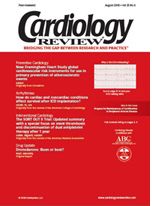Publication
Article
GLP-1%u2013based therapy improves cardiovascular risk factors
Diabetes
San Diego—New treatments for type 2 diabetes are focusing on increasing circulating levels of glucagon-like peptide-1 (GLP-1), a crucial incretin hormone released from the intestinal tract that stimulates beta cells to produce insulin.
A new class of agents that act on
GLP-1, the incretin mimetics, was the subject of several presentations at the 65th Annual Scientific Sessions of the American Diabetes Association. The first of the incretin mimetics to be approved by the FDA is exenatide (Byetta), which produced sustained improvements in glucose control and weight, in addition to clinically meaningful improvements in cardiovascular risk factors.
GLP-1 inhibits glucagon secretion, regulates gastric function, and may promote satiety—effects that reduce glycemic excursions after food intake, said David D’Alessio, MD. These effects are less pronounced in patients with diabetes.
Persons with type 2 diabetes produce high levels of glucagon, signaling the liver to produce glucose. Pharmacologic administration of GLP-1 has been shown to improve glycemia in patients with diabetes through suppression of glucagon secretion and gastric emptying, as well as by stimulating the beta cell, said Dr. D’Alessio, associate professor of medicine, University of Cincinnati.
“The main effect of GLP-1 treatment is to modify islet function,” said Bo Ahrén, MD. “Defective islet function is a key defect for not only the cause of the disease but also for the progressive deterioration of the disease. If we can affect the islet function in a beneficial way, we have for the first time a treatment modality that can potentially modify the disease process.”
GLP-1—based therapy may fulfill several unmet needs in the treatment of type 2 diabetes, said Dr. Ahrén, professor of medicine, and head, research department, Lund University Hospital, Malmö, Sweden. No other treatments that are available inhibit glucagon secretion or increase beta cell mass, he said.
GLP-1 is rapidly inactivated by the enzyme dipeptidyl peptidase IV (DPP-IV), making it unattractive as a treatment. Two strategies have evolved to overcome this drawback, however, the first being injectable GLP-1 receptor agonists such as exenatide. The second strategy is to inhibit DPP-IV and thereby take advantage of the increase of GLP-1 after each meal, increasing the endogenous concentration of GLP-1. The DPP-IV inhibitor farthest along in clinical trials is vildagliptin, which can be given orally.
In open-label extension studies of 265 patients treated for an average of more than 82 weeks, exenatide in combination with metformin, a sulfonylurea, or both, resulted in an average reduction in glycosylated hemoglobin (A1C) levels of 1.2% and an average body weight reduction of 10.1 lb, said David Kendall, MD, chief of clinical services and medical director at the International Diabetes Center in Minneapolis.
Furthermore, favorable changes in triglycerides, high-density lipoprotein (HDL) cholesterol, and blood pressure were observed with exenatide. From baseline to 82 weeks, triglycerides decreased by a mean of 36.94 mg/dL, HDL cholesterol increased by a mean of 4.46 mg/dL, and blood pressure declined by a mean of 1.48/3.24 mm Hg. “Improvements in cardiovascular risk factors were greatest in patients who experienced the greatest reductions in weight,” said Dr. Kendall.
Vildagliptin is an oral DPP-IV inhibitor that has been shown to improve glucose tolerance, maintain the insulin response, and decrease glucagon response in type 2 diabetes, said Steven E. Kahn, MB, professor of medicine, University of Washington, Seattle. Vildagliptin acts in synergy with metformin to improve glucose control and beta cell function.
When given with metformin for 1 year, vildagliptin improved beta cell func-
tion and increased sensitivity to insulin after eating a meal compared with patients taking metformin alone, reported Dr. Ahrén. In animal models, vildaglip-
tin treatment decreased the rate of beta cell death and increased beta cell replication, leading to a 40% to 50% increase in the number of insulin-producing beta cells. Phase 3 studies of vildagliptin are continuing.
